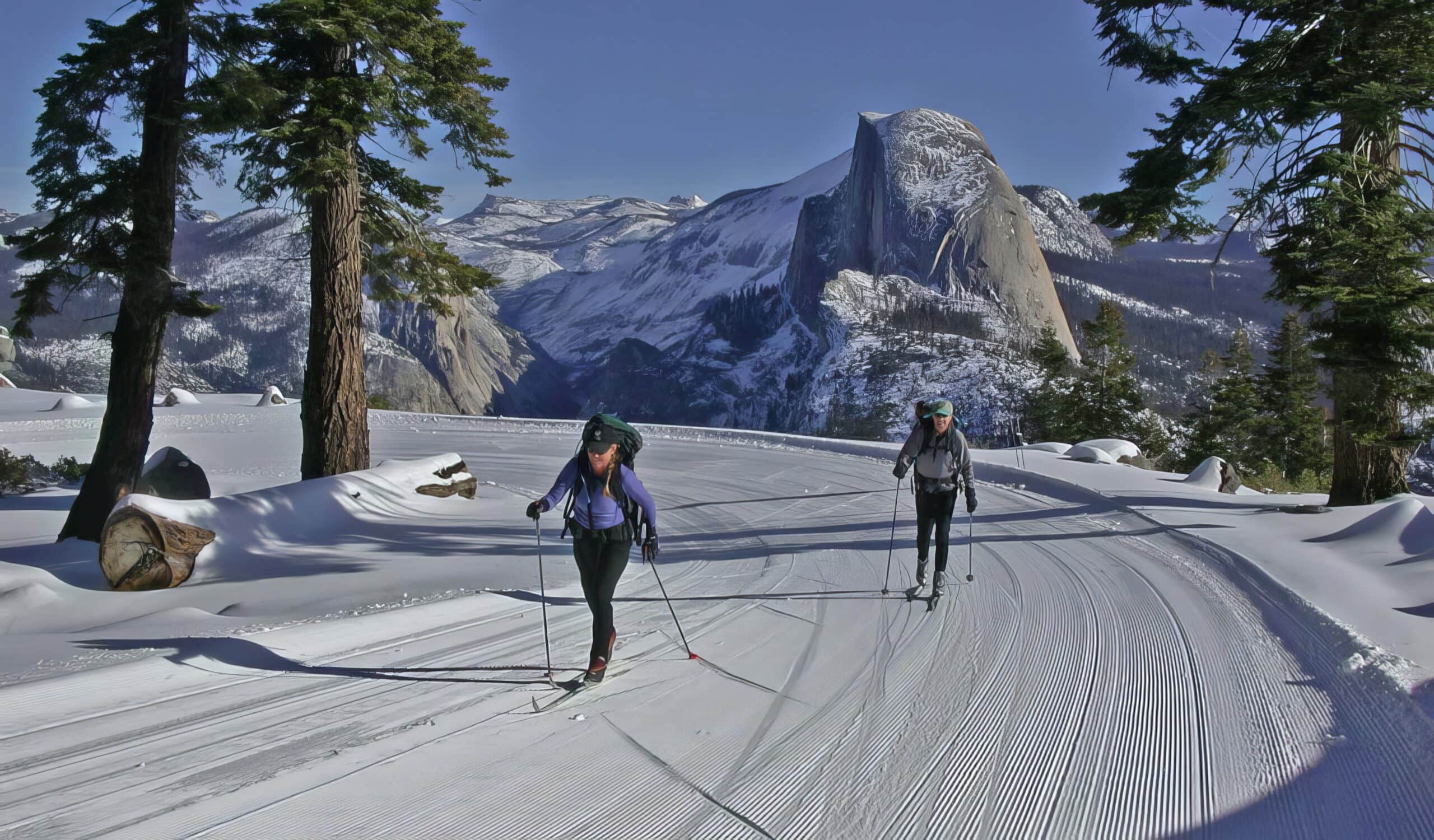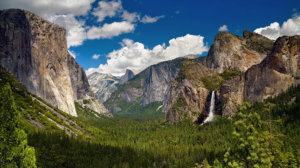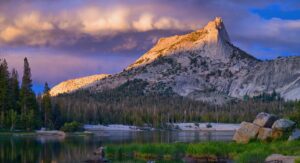Cross country skiing on winter’s blanket of snow is one of the best and most efficient ways to explore the Yosemite high country during the winter. Unlike snowshoes which require a wider-than-normal stance that can tire you out quickly, XC skis allow a more natural stride on the uphills and a fun and exhilarating ride on the downhills.
When winter stars at Yosemite, snow closes roads and trails at higher elevations but opens other doors. Summer-dry waterfalls are suddenly refreshed, lower seasonal visitation contributes to the naturally quiet state of snow, and winter’s games come to the fore.
For those eager to explore Yosemite’s winter wonderland on XC skis, Badger Pass Ski Area is a High Sierra hub for Nordic cross country facilities and terrain. Whether it is your first time on those skinny skis or linked Telemark turns are your thing, cross country skiing offers a way to glide through the woods on the way to big views. Here’s how to play.
Gear Up for Yosemite Cross Country Skiing!
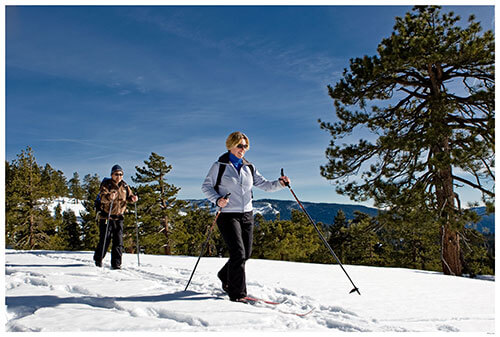
For those new to the sport, or for those who have only experienced downhill skiing at a ski resort, a cross country ski center with machine groomed trails, gear for rent, and lessons is the perfect introduction. The Nordic Center at Yosemite National Park’s Badger Pass Ski Area, just off Glacier Point Road, checks all these boxes.
Most people just starting out will want to try classic cross country skiing, also called striding. Stride skis have a patterned base (or soft wax) that keeps the ski from sliding backward when pressed into the snow. This allows skiers to push off and slide forward with each step. The lightweight boots and free-heel make it easy to simply “walk” on XC skis, but mastering the rhythm and technique to glide on skis takes moving across the snow to a whole new level. Lessons provided at the Nordic Center can help you gain the confidence and skills to appreciate the finer points of skimming across the snow on skis. Plus, you’ll learn what to do when going up a hill too steep for the traction provided by the patterned base, along with how to turn and stop on the way back down again. Just a couple of hours spent under the tutelage of a professional instructor and away you go on a fun, full-body workout with views and fresh forest oxygen to burn.
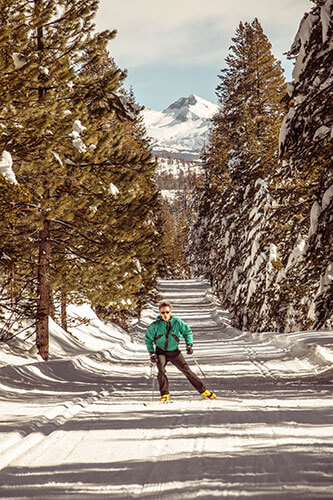
Once you’re comfortable with classic cross country skiing in Yosemite, come back to try skate skiing. Instead of a walking motion, skate skiers use a side-to-side movement like someone on ice skates or rollerblades. Combine that with extra-long poles for even more propulsion, and skate skiers can really fly. If you are on the groomed trails, you may see them sailing by in the wide center lane between the striding ski tracks. Skate skiing is also highly aerobic. If stride skiing is like walking – whether you’re out for a stroll or taking a brisk walk – skate skiing is like running. You can slow the pace, but per unit time, it’s going to take more energy than striding.
A third “style” of Nordic skiing, also available at Badger Pass’ Nordic Center, focuses on the downhill aspect of the sport. For those accustomed to downhill skiing, cross country skis are lighter and harder to control on the downhill. Plus, the free heel makes it even more essential to maintain front-back balance. If you get thrown forward on your skis, it’s easy to pivot on the toe-binding and end up face-first in the snow. In order to compensate for that, free-heel skiers adopted a special stance with one foot slightly ahead of the other in what’s known as a telemark turn. Another way to make downhilling easier is to adjust the design of the skis. Take a classic ski, make it wider and heavier, and add metal edges to cut into hard-packed snow. Throw in a curvier shape more suited to turning with stiffer boots and bindings for more control. Now you have a telemark ski. The Nordic Center at Badger Pass offers a range of telemark ski options from straight-sided skis with metal edges to shaped skis that are perfectly at home on the slopes at the downhill ski area.
Cross Country Ski Equipment Rentals
The Nordic Center at Badger Pass rents all types of Nordic skis (classic, skate and telemark) along with poles and boots, so you have everything you need to get started in one place. Cross country ski rentals are typically a fraction of what downhill gear will cost, so this is an affordable way to explore and slide on the snow.
Cross Country Skiing Lessons: Learn From the Pros
Take advantage of daily lessons to get the most out of your time on XC skis. The friendly and helpful instructors at Badger Pass can help with classic cross country, skate and telemark ski lessons. Join a group class, or get personalized instruction with a private lesson.
To take it even one step further, sign up for a guided backcountry ski tour. Visit the coolest places, and brush up your skills at the same time. This is a great way to learn techniques for handling ungroomed snow, gather ideas for more places to explore, and enjoy a great day on the snow.
Popular Yosemite Cross Country Skiing Trails & Winter Routes
Badger Pass Ski Area
Badger Pass Ski Area is the hub for more than 90 miles of marked cross country trail systems, including 25 miles of groomed trails leading through snow-covered pines and out to epic views of Yosemite Valley and High Sierra mountain range vistas. In the winter, Glacier Point Road closes beyond the Badger Pass Ski Area and turns into a beautiful machine groomed track through the Yosemite wilderness, 10.5 miles to Glacier Point. Power up to Glacier Point when you’re ready for the challenge of a 21 mile (34 km) round trip to the iconic Yosemite Valley overlook. Or spend the day exploring the network of ungroomed trails.
Ungroomed winter ski routes are marked with trail blazes – metal signs and rectangles placed high in trees to stay above the snow in winter. Keep in mind that trees can fall down and the markers can become obscured, so a map and compass are a good idea. Some of these trails are well-traveled and it’s easy to follow in others’ tracks. However, if something seems off, remember to ask yourself if the people ahead of you knew where they were going, or if they were going to the same place you want to go.
Dewey Point
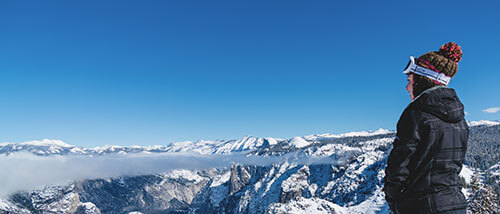
The pair of marked, well-traveled trails from Badger Pass Ski Area to Dewey Point are some of the most popular trails in the area. The popularity is well-earned for those seeking great cross country skiing in Yosemite Valley. The trails lead to a spectacular vista point overlooking Yosemite Valley and El Capitan. There are precious few places on Earth where you can be face to face with anything like the nose of El Capitan!
The Dewey Point Trail winds through forest and meadow before reaching the valley rim and rendering breathtaking views from an elevation of 7,385 feet.
To get there, head east on Glacier Point Road, climbing gently and then cresting a hill before dropping into Summit Meadow, about a mile (1.6 km) from the Badger Pass parking lot. Pass the small outhouse on the right, then look for the signs for the Dewey Point Meadow Trail (#18) breaking from the road and heading north. The first part of this trail is a relatively flat and relaxing ski through a wide-open meadow. Then the route steepens as you get closer to Dewey Point, passing through steep tree-filled slopes.
Those up for an exhilarating challenge can return via the rolling Dewey Point Ridge Trail (#14) that leads back to Glacier Point Road and Badger Pass parking. It’s about 7 miles (11.2 km) round trip.
Glacier Point
Glacier Point, which towers 3,200 feet above the valley floor, offers some of the most incredible views in all of Yosemite — including Yosemite Valley, Half Dome, and the Yosemite High Country. Glacier Point is also a popular cross country ski destination for advanced skill levels. The distance from Badger Pass Ski Area to Glacier Point is approximately 10.5 miles. If you are up for a 21-mile round trip roundtrip trek in a single day, then an out-and-back trip to Glacier Point may be calling you. More often, when the Glacier Point Ski Hut is open, skiers camp or spend the night at the Glacier Point Ski Hut before making the return journey. Here is one perspective on making the XC Ski trip to Glacier Point.
Cross Country Skiing in California’s Mariposa County: Beyond Badger Pass
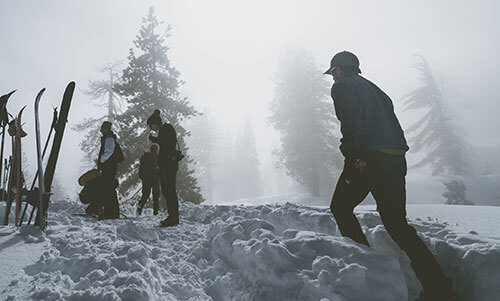
Crane Flat Area
Crane Flat is located 16 miles from Yosemite Valley at the junction of the Big Oak Flat and Tioga Roads. When snow covers the area’s pleasant meadows they transform into delightful cross country terrain. Some routes marked for winter use include Gin Flat Loop Trail, Crane Flat Campground, and Clark Range View Trail. While trails are not groomed in the Crane Flat area, you can still find great first-time terrain for beginning skiers.
Two of the trails in the general Crane Flat area worth special note are the trails that descend into the Merced Grove and the Tuolumne Grove. The trail through the Tuolumne Grove is only a mile (1.6 km) long, and the Merced Grove trail is only slightly longer at 1.5 miles (2.4 km). The gentle path leads to dozens of majestic giant sequoias, among the largest and oldest living things on the planet. Just remember that the outbound portion of the trail is downhill, so make sure you save some energy for the trek back up to the parking area.
Mariposa Grove of Giant Sequoias
Yosemite’s largest and most impressive grove of giant sequoias, the Mariposa Grove of Giant Sequoias is located just two miles from the park’s south entrance gate. The contrast of the ruddy giant sequoia bark with sparkling white snow is like yin and yang and well worth a special trip.
The Mariposa Grove shuttle doesn’t run during the winter and the road is left unplowed for the enjoyment of skiers and snowshoers. The trails are not machine groomed, but several are marked with blazes to make them easier to follow in snowy conditions. The new Washburn Trail from the far end of the parking area to the lower grove is a beautiful forested path, though beginner skiers might prefer the more open and less winding option of skiing along the closed road up to the main grove. The road certainly makes for a speedier and effortless descent to the car at the end of the day.
Other Yosemite Trails
Most Yosemite trails remain open all winter long, even if they are covered with snow. Furthermore, from a Leave No Trace perspective, the snow shields the ground below from trampling and traffic making winter an excellent time to venture out to new places. If you decide to ski out to some high elevation destinations in Yosemite remember that unlike the trails mentioned above, regular trails are not marked for winter travel. Make sure you’re up for the challenge and that you know how to stay safe. See the Trail Wisdom section below for tips.
Multi-Day Cross Country Skiing Adventures
For multi-day adventures, you may be able to break up your winter camping with a stay in one of Yosemite’s winter huts.
The Glacier Point Hut and Ostrander Hut are both located along marked ski trails that start at Badger Pass Ski Area and are relatively easy to find.
The Snow Creek Cabin, on Yosemite’s north rim below Mt Watkins, is limited to six people per night generally from mid-December through March. You can pick up a wilderness permit (if available) and the current combination for the cabin’s lock at the Valley Visitor Center one day before your trip.
Even further afield is the Tuolumne Ski Hut. Located near the Tuolumne Meadows Campground, this hut is staffed by the Tuolumne Winter rangers and has 10 bunks available on a first-come, first-served basis.
Wonderful Winter Trail Wisdom for Cross Country Skiing in California
The breathtaking rewards of cross country skiing require heightened preparation, safety awareness, and a touch of etiquette. Here is what you need to know about traveling across snow in Yosemite:
- Fresh snow can obscure trails and ski tracks, making it difficult to find your way. Bring a map and compass, and know how to use them (GPS devices don’t always work in the Yosemite high country). If you’re not comfortable navigating, stick to clearly marked groomed trails, generally located by orange markers.
- There are some specific rules of the cross country road.
- Skiers and snowshoers/hikers should set their own tracks. Not only are the paths and turning radiuses different, footprints can ruin the most carefully-laid ski track.
- Yield to skiers heading downhill, to avoid crashes.
- Before you leave on a trip, let someone know where you’re going and when you’ll return.
- Keep track of others in your party.
- Ski out what you pack in, including all trash and food waste.
- Monitor Yosemite National Park weather and road conditions here. One of the best resources for Yosemite high country conditions is the Tuolumne Snow Report, created by Tuolumne Meadows winter rangers. For updated Yosemite National Park road and weather conditions, call (209) 372-0200, and know that winter storms can appear quickly out of the blue.
- Snow and ice, limited daylight, cold temperatures and quickly changing conditions can complicate what might seem like a short, simple itinerary. No matter where you’re headed, take time to familiarize yourself with your route, monitor weather and avalanche conditions and talk to a ranger about what to expect.
Here’s what goes in your backpack:
- Navigation tools (map, compass, GPS, smartphone with downloaded, offline maps).
- Sun protection. It might be chilly, but you still need sunglasses and sunscreen to protect your eyes and skin.
- Insulating layers are your key to happiness in cold weather. Cross country skiing is a workout, and sweat happens even in the snow. Essential are top and bottom layers that will keep you warm and dry, hat, gloves, and a waterproof jacket or shell. For those layers, go with wool, polypropylene or other moisture-wicking, quick-drying materials. Damp cotton layers will not be your friend.
- Flashlight or headlamp, plus extra batteries.
- First aid kit.
- Plenty of quick-energy food, including enough snacks to get you through an extra day in case your plans change unexpectedly.
- More water than you think you’ll need, plus water filtration or treatment supplies. Hydration requirements ramp up at elevations that support snow.
- Emergency shelter, such as a tent, tarp or superlight sleep sack.
- Basic repair tools (duct tape, knife, screwdriver, scissors).
- Waterproof matches or lighter.
Glide On You Snowy Angels
There’s a reason why cross country skiing in Yosemite is gaining wildly in popularity. It’s economical compared to alpine skiing, gets you on trails less traveled, and affords a more “natural” option for winter recreation. In addition, studies show that more snow angels are made by cross country ski enthusiasts than snowboarders or alpine skiers. Happy gliding!

